The pick-ups 'saving lives on the front line' in Ukraine
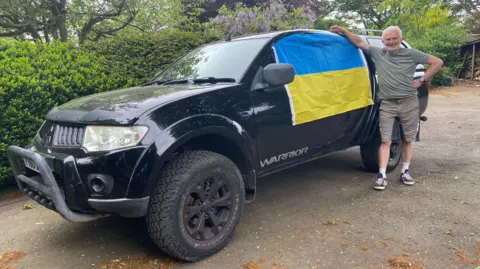 BBC
BBCA Black Mitsubishi Warrior sits in the car park, mud splatters and bullet holes giving a hint at its recent history.
"This could be a shotgun” says Oleg Lutsyk looking at the rips and tears in the metal of the driver’s door.
"But I think it was from a mortar, some pieces from the mortar or artillery ammunition that got inside the vehicle.”
He points to a series of smaller, rounder holes further along.
“This one is for sure from some shotguns,” he says.
The pick-up took several direct hits rushing Ukrainian troops from the battlefield in their war with Russia.
Oleg is part of the team patching it up so it can be returned to the front line.
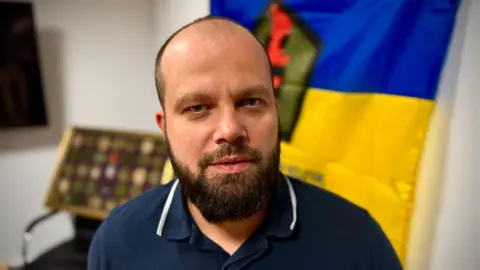
It arrived in Ukraine last year as part of a convoy delivered by the Scottish charity Pickups for Peace.
It was then donated to Ukraine’s 80th Air Assault Brigade - a unit which helped lead the Kursk offensive as Ukrainian troops pushed into Russian territory.
The pick-up played a vital role in taking troops from the battlefield.
“Fortunately, all the soldiers who were there are alive,” Mr Lutsyk.
“Maybe some of them got a little injured. But everything is OK with them.”
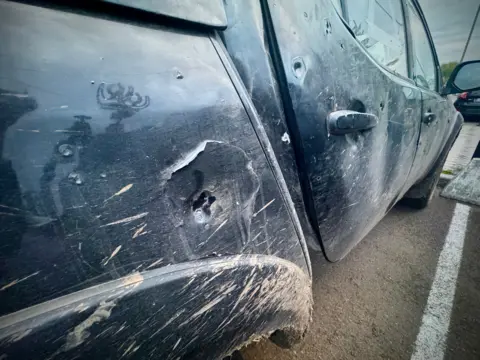
The pick-up came from Norfolk. It was driven across Europe by Keith and Ultan, a father and son team who described the journey as “a rollercoaster of emotions".
It is part of a steady flow of donated vehicles brought to the country to support the war effort.
The charity – started by farmers in Angus, Peebles and Wiltshire - has now transported 500 of them from across Scotland and around the UK.
Another Scottish charity – Jeeps for Peace – has sent more than 360 vehicles in nine separate convoys too, and a third organisation – Car for Ukraine – contributed 4x4s from Wales as part of the effort.
Volunteers from Edinburgh, Perth and Islay delivered the latest convoy this week, bringing the total to more than 800 drivers and passengers who have made the journey - the youngest just 18 years old and the oldest 85.
The cars have taken part in rescue missions, evacuations, and anti-drone work - and the charities involved say they have now saved thousands of lives on the front line.
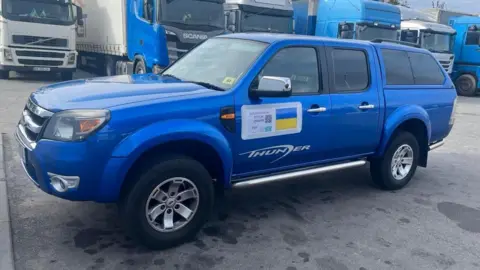 Pickups for Peace
Pickups for PeaceAndriy Kovalskyi is the head of the Lviv District Military Administration. He keeps the convoys moving smoothly and free of bureaucratic hold-ups as they cross the border.
He says the vehicles are important to the troops but the effects go far beyond just military aid.
“British citizens come personally as drivers within the convoys, acting later as ambassadors for Ukraine, witnessing the state of war in this country," he says.
Andriy's city is safer than many in Ukraine but it is not immune to missile and drone strikes, as the volunteers have discovered.
"Quite a few times they themselves had to go downstairs to the shelter in the hotel they stayed at," he says.
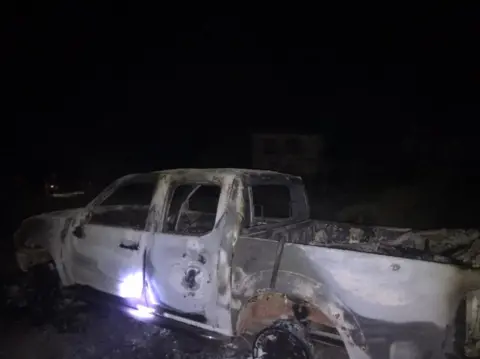
The Lviv administration has done everything it can to encourage the flow of UK vehicles through the city and on to the battlefield - and the car park outside its headquarters has become a grand handover point.
The volunteers bring the vehicles and meet some of the soldiers who will take them forward.
There are speeches and some ceremony but then almost immediately they are taken into battle.
“When they are handed over all the cars are in very good shape,” says Derek Fleming.
Born and raised in Aberdeenshire and Moray but living in Ukraine for the past 25 years, Derek has played a part in the movement of almost every convoy one way or another.
He said: "Some cars are 15 years old but they are mechanically sound… and they go to different battalions.
"Some, directly the next day, head off to the East."
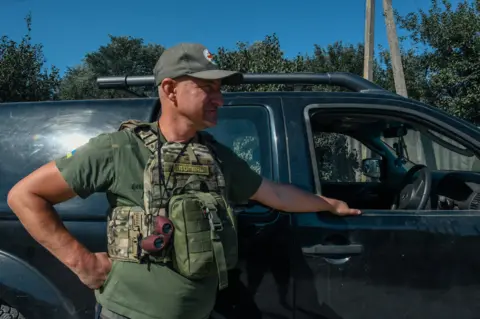
Details have emerged about exactly where the vehicles ended up and how they have been used.
Seven of them were donated to the 2nd Drone Brigade of Ukraine’s National Guard, who have taken them to help defend Pokrovsk, a strategic transport hub that has become the focus of intense fighting in the past few months.
Another 25 remained with the Air Defence Forces of Western Ukraine, their role is to try and bring down Russian attack drones if they threaten Lviv and the surrounding area.
In Avdiyivka – in eastern Ukraine – one of the vehicles rescued a group of Ukrainian soldiers who had been surrounded as the town was reduced to rubble before falling to the Russians at the end of February this year.
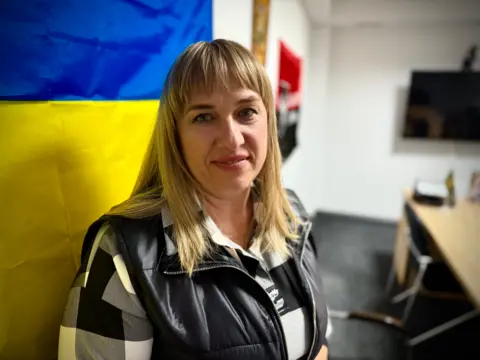
A blue Ford Ranger was among the 4x4s that arrived earlier this year. It was driven from Northumberland by two volunteers, Jeff and John.
Jeff - a British Army veteran - said: "Having spent most of my life in the military it was good to be able to help other soldiers in a small way."
Despite being 14 years old, the Ford still looked quite new.
As it made its way through the Ukrainian countryside there was still a yellow AA sticker on its windscreen, another white one on its back identified it as coming from the UK.
A few weeks later it was a burned-out shell.
Phone video shot by those on the ground in the aftermath of a grenade attack outside Pokrovsk shows its utter destruction, the paint had been burned clean off, most of the exterior destroyed, the inside was incinerated, but thankfully nobody was hurt as it went up in flames.
Those images are sobering for the staff back in Lviv as they work hard to send more and more vehicles to the front.
'More of them stay alive'
Andrey Ohinok is part of a hardened group of Ukrainian drivers known as the Jackie Chan Volunteers who take the pick-ups on to the battlefield when regular troops can’t.
He says it’s all about keeping their combat comrades on the move.
"The more mobile they are, the more of them stay alive," he says.
He is not the only one to speak in plain but dramatic terms about the work they are involved in.
Ira Savka helps co-ordinate the charity’s operations in Lviv including distributing the more than £3m of aid that has gradually arrived inside the vehicles.
“We hope we are doing the right job, at the right time for the right cause,” she says.
A few miles from where she is speaking there is a scene that brings the job, the time and the cause, into sharp and painful relief for the citizens of this city.
At the military cemetery of the Field of Mars, the sea of yellow and blue flags fluttering over the graves of Ukraine’s war dead is massive and continues to grow each week.
As the full-scale conflict approaches 1,000 days it is a brutal reminder – if one was needed – of everything this war has already cost their country.
